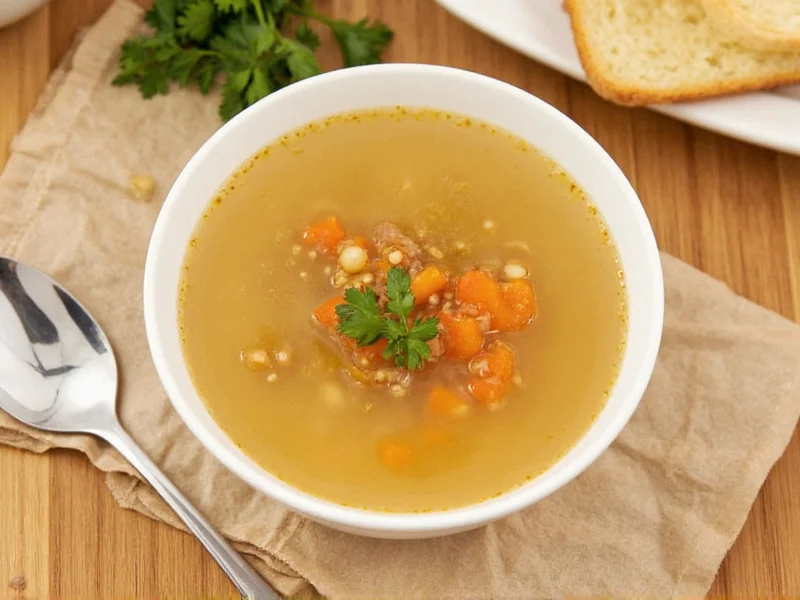The fastest way to make delicious chicken soup with chicken broth starts by sautéing onions, carrots, and celery in olive oil until softened. Add 4 cups of quality chicken broth, 2 cups shredded cooked chicken, 1 cup diced vegetables (like carrots and celery), 1/2 teaspoon dried thyme, and a bay leaf. Simmer for 15-20 minutes until vegetables are tender. Season with salt and pepper to taste. For extra richness, stir in 1/4 cup fresh parsley just before serving. This simple method creates a comforting, restaurant-quality soup in under 30 minutes using pantry staples.
Why Chicken Broth Makes the Perfect Soup Base
Creating satisfying chicken soup doesn't require hours of simmering bones. Using quality chicken broth as your foundation delivers consistent results while saving valuable time. The key is knowing how to elevate store-bought broth into something that tastes homemade. Many home cooks don't realize that with proper technique, canned or boxed broth can transform into a deeply flavorful soup that rivals traditional recipes made from scratch.
Essential Ingredients for Flavorful Chicken Soup
The magic happens when you combine quality ingredients with proper technique. Here's what you'll need for the best chicken soup with chicken broth:
| Ingredient | Why It Matters | Smart Substitutions |
|---|---|---|
| 4 cups good quality chicken broth | Forms the flavorful base; low-sodium gives you control over seasoning | Homemade stock, vegetable broth for variation |
| 2 cups cooked chicken | Shredded rotisserie chicken works perfectly | Diced cooked turkey, omit for vegetarian version |
| 1 medium onion, diced | Provides foundational sweetness and depth | Shallots for milder flavor |
| 2 carrots, sliced | Adds natural sweetness and texture | Parsnips, sweet potatoes |
| 2 celery stalks, chopped | Contributes herbal notes and complexity | Fennel bulb for anise flavor |
| 2 tbsp olive oil | For properly sautéing vegetables | Butter, avocado oil |
| 1 tsp dried thyme | Classic herb that complements chicken | Rosemary, poultry seasoning |
Step-by-Step Method for Perfect Broth-Based Chicken Soup
Follow these professional techniques to transform basic chicken broth into an exceptional soup:
- Sauté vegetables properly: Heat olive oil in a large pot over medium heat. Add onions, carrots, and celery with a pinch of salt. Cook for 8-10 minutes until softened but not browned. This "sweating" technique draws out natural sugars without caramelizing.
- Build flavor layers: Stir in 2 cloves minced garlic and 1 teaspoon dried thyme. Cook for 1 minute until fragrant. This step activates the essential oils in the herbs.
- Add broth gradually: Pour in 4 cups of low-sodium chicken broth while scraping the bottom of the pot to incorporate all the flavorful bits (fond) from sautéing.
- Incorporate chicken: Add 2 cups shredded cooked chicken. Rotisserie chicken works perfectly here, but leftover roasted chicken or poached chicken breasts also work well.
- Simmer gently: Bring to a gentle simmer (not a rolling boil) and cook for 15-20 minutes. Over-boiling can make chicken tough and cloud the broth.
- Finish with fresh elements: Remove bay leaf, then stir in 1/4 cup chopped fresh parsley and adjust seasoning. For richer texture, add 1/4 cup uncooked small pasta or rice during the last 10 minutes of cooking.
Pro Tips for Elevating Store-Bought Broth
Many home cooks miss these simple techniques that transform basic broth into something extraordinary:
- Add umami boosters: Stir in 1 tablespoon soy sauce or 2 teaspoons tomato paste while sautéing vegetables for deeper flavor without making the soup taste Asian-inspired.
- Use the freezer trick: Freeze broth in ice cube trays, then store cubes in freezer bags. This lets you use exact amounts without wasting partially used containers.
- Acid balance: A splash of lemon juice or apple cider vinegar just before serving brightens flavors and makes the soup taste fresher.
- Fat matters: Don't drain all fat from your sauté pan—those browned bits contain concentrated flavor that dissolves into the broth.
- Texture control: For clearer broth, avoid boiling vigorously. For heartier texture, add 1 diced potato during simmering—it naturally thickens the soup.
Popular Variations to Customize Your Soup
Once you master the basic technique, experiment with these easy adaptations:
Creamy Chicken and Wild Rice Soup
Replace 1 cup broth with heavy cream and add 1/2 cup rinsed wild rice blend. Simmer until rice is tender (about 45 minutes). Stir in 2 tablespoons Dijon mustard for complexity.
Asian-Inspired Chicken Broth Soup
Add 1 tablespoon fresh ginger, 2 sliced scallions, and 1 tablespoon rice vinegar. Replace half the broth with mushroom broth. Top with cilantro and a dash of sesame oil before serving.
Weeknight Chicken Noodle Soup
Add 2 cups egg noodles during the last 8 minutes of cooking. For extra richness, stir in 1/4 cup grated Parmesan cheese just before serving.
Storage and Reheating Guidelines
Proper storage maintains quality and food safety:
- Cool soup completely before refrigerating—never put hot soup directly in the fridge
- Store in airtight containers for up to 4 days in the refrigerator
- Freeze in portion-sized containers for up to 3 months
- Reheat gently on the stove over medium-low heat, stirring occasionally
- Add a splash of water or broth when reheating frozen soup as it may thicken during storage
Troubleshooting Common Problems
Solve these frequent issues with broth-based chicken soup:
Soup tastes bland
Solution: Add salt in small increments while soup simmers. Try 1/4 teaspoon at a time. Acid (lemon juice or vinegar) often makes flavors pop more than additional salt.
Soup is too salty
Solution: Add raw potato chunks and simmer for 15 minutes—they absorb excess salt. Alternatively, dilute with additional unsalted broth or water.
Broth looks cloudy
Solution: This happens from boiling too vigorously. For clearer broth next time, maintain a gentle simmer. Cloudiness doesn't affect flavor.
Chicken turned rubbery
Solution: Add pre-cooked chicken during the last 5 minutes of cooking. Overcooking makes chicken tough.











 浙公网安备
33010002000092号
浙公网安备
33010002000092号 浙B2-20120091-4
浙B2-20120091-4